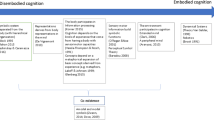Abstract
To what extent is imagination dependent on embodied experience? In attempting to answer such questions I consider the experiences of those who have to come to terms with altered neurological function, namely those with spinal cord injury at the neck. These people have each lost all sensation and movement below the neck. How might these new ways of living affect their imagination?
Similar content being viewed by others
References
Cole, J. 1998. About Face. Cambridge: MA and London: The MIT Press.
Damasio, A. 2000. The Feeling of What Happens. New York: Random House.
Decety, J. and Boisson, D. 1990. Effect of brain and spinal cord injuries on motor imagery. European Archives of Psychiatry and Clinical Neuroscience 240: 39–43.
Hill, J. 2000. Footprints in the Snow. London: Macmillan, Pan paperback.
Lacourse, M. G., Cohen, M. J., Lawrence, K. E. and Romero, D. H. 1999. Cortical potentials during imagined movements in individuals with chronic spinal cord injuries. Behavioural Brain Research 104: 73–88.
Morris, J. (ed.). 1989. Able Lives: Women’s Experience of Paralysis. London: The Women’s Press.
Reeve, C. 2002. Nothing is Impossible. New York: Random House.
Rose, M., Robinson, J., Ells, J. and Cole, J. D. 1988. Pain following spinal cord injury: Results from a postal survey. Pain 34: 101–102.
Robert, M. 1987. The Body Silent. New York: Henry Holt.
Sabbah, P., Leveque, C., Pfefer, F. et al. 2000. Functional MR imaging and traumatic paraplegia: Preliminary report. J Neuroradiology 27: 233–237.
Shoham, S., Halgren, E., Maynard, E. M. and Normann, R. A. 2001. Motor-cortical activity in tetraplegics. Nature 413: 793.
Stensman, R. 1994. Adjustment to traumatic spinal cord injury. A longitudinal study of self-reported quality of life. Paraplegia 32(6): 416–422.
Stormer, S., Gerner, H. J., Gruninger, W., Metzmacher, K., Follinger, S., Wienke, C., Aldinger, W., Walker, N., Zimmermann, M. and Paeslack, V. 1997. Chronic pain/dysaesthesiae in spinal cord injury patients: Results of a multicentre study. Spinal Cord 35(7): 446–455.
Author information
Authors and Affiliations
Corresponding author
Rights and permissions
About this article
Cite this article
Cole, J. Imagination after neurological losses of movement and sensation: The experience of spinal cord injury. Phenom Cogn Sci 4, 183–195 (2005). https://doi.org/10.1007/s11097-005-0138-6
Issue Date:
DOI: https://doi.org/10.1007/s11097-005-0138-6




